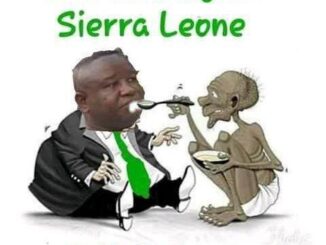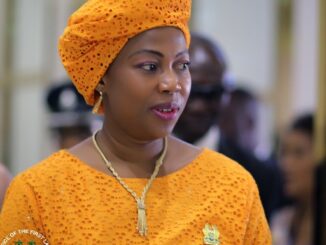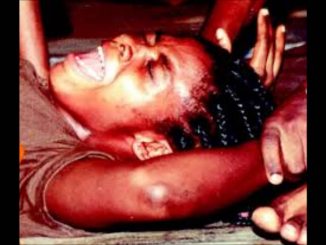By Mathew Kijangbe
Dear Friends,
I thank you for your interest in Chief Hinga Norman. I know how jittering it is to hear that a defender of the Homeland is indicted for Crime Against Humanity. While I do not want to undermine the credibility of the International Court with a $60M cash in its coffers and aims at putting very high profile names on the war crime list, I am here simply to give a prognosis of how former Captain Hinga Norman became known as the peoples’ Chief and how he put a combination of his military training and valor to the wheel to defend the people.
Once more I crave your indulgence to go through this article with the mind of understanding the complex interplays between the genuine efforts to pulverize the rebel insurgency against the gradient of betrayed patriotism, subterranean current to resurrect a failed regime or to sustain the kleptomaniac tendencies that had become a philosophical path for many people in cohort with the combatants. Again I would endeavor to use eyewitness accounts and credible sources of information. Therefore I would like to start with my own person experiences or what I know about him and the debut of his regency of the Njaiama-Bongor Chieftaincy.
The NPRC Consideration
The NPRC came into power by an unconstitutional military take over of former President Joseph S. Momoh-which ended the 24-year rule of the APC. There was no referendum to legitimize the NPRC rule. However, because Sierra Leoneans both the intelligential and the ordinary people were fed-up with the patent dictatorship of the APC, misgovernment, the downward trend of the fiscal stability, the lack of political maturity, corruption and mismanagement and misappropriation, dependency of the government on the military machismo to sustain the APC rule against democratic principles and practices, the ordinary people marched the streets of Freetown, philosophically pledging support for the NPRC. For most people the NPRC was considered as a lesser of two evils. The people hoped that international pressure would bear on the military government to hand over power through an acceptable democratic process.
By the time the NPRC took over the reign of government, the rebel insurgency was gradually engulfing important commercial routes and diamond areas. The security corridors were not holding for a number of cities. The rebels had taken over the whole of Kailahun district, captured most of the important towns in Kenema District and Pujehun District was under their control, the inter-land ofBonthe District and some part of Bo District had already fallen.
This advancement of the rebels worried the NPRC government. Why? Because the ordinary Sierra Leoneans were very hopeful that the Military government would bring a speedy conclusion to the rebel menace. Since Koribondo was at a center of very important four forked road, the NPRC considered making Koribondo a military base, that would monster the military capacity to halt any rebel advances from Small Bo (Blama), Wonde, Bandajuma Sowa (in Pujehun), Sumbuya, Torma Bum and Jimmi Bagbo respectively. It can be recalled that the rebels had already taken the whole of Shan Malene Chiefdom and had made it their doyen because of its strategic location, the food, palm oil and diamonds. I also need to remind my friends that David Minah, the Commissioner had failed to elect the substantive Paramount Chief of Njaiama Bongor Chiefdom on two consecutive occasions.
NPRC Norman Appointed Captain Hinga Norman
Considering the complexity of the rebel advances into the heartland of the South and Eastern Provinces, the NPRC decided to have two military old hands into the local government. One of the military old hands, Captain Foyah was placed in Ngorama Chiefdom and Captain Norman in Njaiama Bongor Chiefdom as regent Chiefs respectively. Why did the NPRC take this decision? Being a military old hand NPRC believed Chief Norman would relate better with the government soldiers if the NPRC decided to have a Military Base in Koribondo, which would be under the jurisdiction of the Chief Norman. Secondly it was assumed that he would be able to work with the local people and provide very important reconnaissance information to the Army.
As Chief, Captain Norman vowed to protect his Chiefdom even under the most conceivable tempest. Soon he made the people to feel at home with him. The void of the loss of their dear Paramount Chief, the legend B.A Foday-Kai was bubbled to capacity. Koribondo was as a military-based. He worked with the soldiers at Koribondo and the roads converging to Bo Town were sealed off from the rebels.
The Sobel Factor
The appointment of Valentine Strasser; who was not originally part of the warfront boys that came to Freetown to request improvement in their situation at the warfront from in the Daru-Segbwema areas, created animosity and subtle acrimony that engineered a sad twist in the rebel war. The latent rejection of Strasser among the army rank and files cajoled the division of the soldiers into Cobra and Tiger Groups respectively. Those who belonged to the Tiger Group were mostly warfront boys and those on the other side were given unmerited promotions and positions. Not only withstanding this, their political patrons were overthrown and some of them striped of their stolen money and sent to jail. The resonance of this acrimony made the Tiger Group to transform itself into a group that determined not only to smear the army but to aid the rebel so that the NPRC ?s ineptitude could be made visible to all and sundry. The group members would wear the same combat uniforms but when they were at the warfront they became allies of the rebels-who they were sworn to fight.
This hidden pernicious gimmickry left many people dead, villages and commercial towns in the ruins and property looted. But the visible contradiction of all was that the rebels would attack a town and the soldiers would go to clear the ambush, but would soon return with trucks full of pots, household utensils, gallons of oil, bushels of coffee beans and others. This was a blatant betrayal of patriotism. Yet the people swallowed the anguish of this betrayal without any hope and assurance.
This latent vengeance as a result of the internal rebellion against the NPRC heavily fell on the lap of the people. This was one of the main factors responsible for the speedy spread of the war and the heinous attendant atrocities that went with it. Through the machination within the army ranks those who did not know about this internal rebellion stood at risk. That was how many of our brothers who were honestly fighting to liberate our country were ambushed by their own colleagues because they were in cohort with the rebels. That is how warriors and decent soldiers like Ben Arsh, T Tengbe, Fallay and TAB Mansaray to name a few lost their lives. Another example was that at a point the NPRC used the local warriors (the Tamaborrohs) headed by a woman from the Korankoh Land in Koinadugu. The very soldiers they were fighting along with ambushed the local hunters.
Evolution of Local Defense
When the local people found out that any village the soldiers were guarding would be an easy target of the rebels, the local people started losing faith in the army to pursue the war to completion. In Bo where I was living, we faced two instances where a disguised soldier ventured to create panic and pandemonium in the township. On one of the two occasions a Sobel started shooting fromPrince Williams Street and was trapped down in a house by ordinary determined civilians at Faagorya Road. But he had killed a young man who attempted to get him down. He never surrendered even when the house owner consented to his house being set on fire only to get rid of the Sobel. After that incident in Bo and the attack on Bo on the December 27, 1994, when the rebels entered New London about � mile from Reservation where the Army was based, stunned the people of Bo. From that time Chief Norman and the local people pleaded with the NPRC Bo Command to allow the local hunters who had guns to be issues licenses so that they can defend theirtowns and villages. With the total support of the people of Bo, the Army Commanders -Major Crew and Idriss Kamara, the Minister could not resist the request of Chief Norman and the people of Bo. The local people supported the local hunters from voluntary contributions of Le.1, 000.00, every month from “market tables” and the same amount from every household heads.
Elsewhere in the country, specifically some young men from Tei in the Tonto-Soli Section of Kwamebai Krim Chiefdom went to fishing on a lagoon called Tamumu, on Lake Mpii in Mano Sa Skrim Chiefdom. Tamumu is about 30 Nautical miles from Tei. For over fives years no one had fished in Tamumu (a very special lagoon for fish) because of the war. The men caught a lot of fish, almost three boats full. While they were happily sailing home, the rebels commanded them to halt and come ashore with their catch. The men refused to obey their command. The rebels then started shooting at them. But the men drawn their catch and dived and surfaced at various parts of the riverbank on the other side of Lake Mapii. After the men re-assembled they asked themselves as to whether they would continue facing this kind of torment from the rebels who had little knowledge about their terrain? This group developed into the most potent resistant group to the Sobels and actual rebels. It was this group that developed into what became known as the Kamajor Society.
Chief Norman and The Hunters
For the same reason the local hunters emerged in Bo and in other places became the motivating factor to start training hunters in and around Telelu Bongor. Chief Norman had trained about 300 hunters. He gave them training including riffle and other military exercises and maneuvers. The local people of Telelu Bongor bought guns and ammunitions for what became known as the Bongor Defense Committee. The Bongor Defense Committee became a robust resisting force that halted the rebel insurgency in Bongor and the surrounding Chiefdoms. While the local people were building their own defense mechanism to provide security to them, the military machismo was hurt or at least felt undermined and their powers undercut. What Idriss Kamara and his boys did was to order a superior force with machine guns and rocket propelled grenades and other conventional weapons to tame Chief Norman and his hunters. Since Idriss Kamara was the Resident Minister for Southern Province, he started sending some of his soldiers to Chief Norman or he started visiting Chief Norman and praising him for his courageous work with the local defense. This was a ploy to understand his force around Telelu Bongor and to know how to take them on with a military surprise. One morning the Sobels from the suspected official headquarters in Bo invaded the Telelu and caused not only surprise but mayhem. Many people perished. Chief Norman himself was believed to be in a house that the Sobels set on fire. The Chief miraculously escaped from this well coordinated onslaught.
While darkness fell over places like Bo, Gerihun, Gondama and other nearly by towns, the military men under Idriss Kamara were in jubilant mood. Their latent happiness over the demise of Chief Norman and his local hunters, made Idriss to excitingly take a video camera crew to Telelu to record the historic massacre of the Bongor Defense Force. They did not only massacre the people but looted their properties.
Ambush Around The Booties
All the looted properties were assembled in a bush near Gondama. One of the hunters who escaped the massacre from Telelu discovered where the Sobels from Bo had gathered the booties. The remnants of the local hunters laid an ambush around the booties. Each time the soldiers-rebels from Bo came to collect those booties faced total casualties. This continued for each group from Bo until it was bitter and stinking. Each time the Sobels faced fatal death from this ambush around the booties, it was called accident. The accidents continued for almost two months, because who ever went to collect the booties never returned to talk about the fire around the booties. This was unfortunate but this was the best way the local hunters knew.
The Cannibalism Factor and Heroism
History has told us that the best way to tarnish the image of a Mende Hero to his relatives and friends is to accuse him of cannibalism. This was what Ibrahim Taqi and Sorie Fornah and others did. Through the unconfirmed accusations they hoodwinked the truth and legally usurped the leadership of the country from Sir. Albert Margai. They succeeded in tarnishing Sir, Alert Magai’s image to the people who formed his political based. Although there was no legitimate proof of all the accusations, but it made even children to openly disrespect him.
Today history is about to repeat itself. Chief Hingaa Norman, after he organized a resistance force that was more gallant than those of the rebels and buffered all the subterranean machinations that had caused unimaginable carnage, rape, pillage, looting and destruction of public and private edifices, and liberated the country from the clutches of those evils rebels, today instead of rewarding him and his men as heroes, they have been tagged as cannibals.
The UN Peace Keepers and The UN Court
Indeed, through the Kamjors Chief Norman was able to communicate to the rebels the only language they understood-“iron cuts iron”. The Kamajors did not have superior force but a self-determined force, predicated on the providential blessing, superior camouflage tactics and superior knowledge of the terrain. The war did not end because of angelic negotiations of the UN or the military fury of the UN Peace Keeping Forces, but because the Kamajors had the upper hand in terms of moral support from their purpose for fighting the rebels even though they had no mainstream financial support and conventional weaponry. On the contrary, the UN soldiers were disarmed, disrobed, disrespected, disturbed, disgraced and detained by the rebels. But with the persistent sacrifices of the Kamajors, those local hunters dismantled the fury of rebel insurgency and forced the rebel combatants to coil their tails between their legs. The UN Court is presently sitting in Sierra Leone because of providential intervention and sacrifices by those Kamajors, some of who are now languishing in solitary confinement.
Well, the International Court has to justify how it spent the $60 Million any way. It has been forestalled by outsiders and inside manipulators that all the factions were involved in human rights abuses. This move has been applauded by higher powers or at least received their blessings. This would be a major bullet from the other side of the political divide if Chief Hinga Norman’s image could be tarnished. This would also legitimize the International court among the powers that be. So, it was easy to tag Chief Hinga Norman as the head of the cannibalism society. “They” concluded that the Kamajors could not use mystical powers to fight the rebels or have crude military training to fights the rebels without eating human beings. Therefore they felt that the Kamajor society was founded to promote cannibalism. The table was turned on its head. The defenders of our people became a faction. What a contradiction. Whatever is not understood by the caricatures of the west is cannibalism. To the ordinary people, all of what is happening now is just reinforcing the love for Chief Norman and his men. Their selfless sacrifices constituted in their sweat, pain on the battlefield and their “bloods” spilled for the liberation of our people will ever remain rolling on our minds and hearts. We hope and pray we will have an opportunity to say “thank you” to them in an orderly and respectable way and not in their eulogies. But if that were to be the ultimate painful reality, we will accept their will and fate and wipe our tears and leave our course to history, time and the conscience of those who gave ill testimonies against them.
(To be continued kijangbe).




Leave a Reply